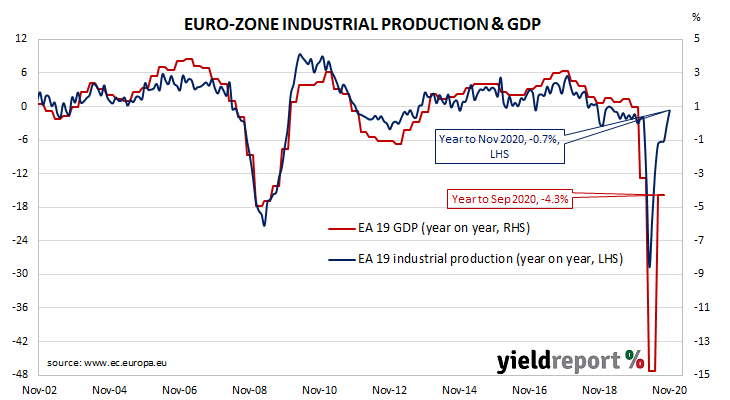Summary: Euro-zone industrial production jumps again; monthly figure much higher than consensus estimate; annual growth nearly back to zero; “uneven recovery across Europe”, huge rise in Irish output.
Following a recession in 2009/2010 and the debt-crisis which flowed from it, euro-zone industrial production recovered and then reached a peak four years later in early 2016. Growth rates then fluctuated through 2016/2017 before beginning a steady and persistent slowdown from the start of 2018. That decline was transformed into a plunge in March and April but the months which followed produced an almost-equally steep bounce.
According to the latest figures released by Eurostat, euro-zone industrial production jumped again in November, this time by 2.5% on a seasonally-adjusted basis. The rise was much higher than the 0.2% increase which had been generally expected and above October’s 2.3% increase after revisions. On an annual basis, the seasonally-adjusted growth rate increased from October’s revised rate of -3.3% to -0.7%*.

German and French 10-year sovereign bond yields moved lower despite the report, slightly outpacing US falls. By the close of business, the German 10-year bund yield had lost 5bps to -0.52% while the French 10-year OAT yield had shed 6bps to -0.32%.
ANZ economist John Bromhead said “the recovery in the index masks an uneven recovery across Europe.” Industrial production growth expanded in just one of the euro-zone’s largest economies. Germany’s production grew by 0.8% while the comparable figures for France, Spain and Italy were -0.9%, -0.6% and -1.4% respectively. Bromhead noted “much of this month’s gain was down to an enormous 52.8% rise in output in Ireland.”
As with other countries’ measures of industrial production, Eurostat’s industrial production index measures the output of industrial sectors in euro-zone countries on aggregate.

